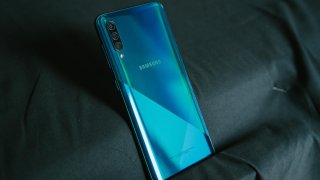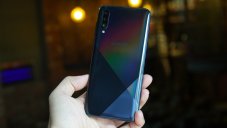Samsung Galaxy A30s
$200 | 18000
- 6.4" 720x1560 pixels
- 25MP 1080p
- 3/4GB RAM Exynos 7904
- 4000mAh Li-Po
Phone Finder
- Acer alcatel Allview Amazon Amoi Apple Archos Asus AT&T Benefon BenQ BenQ-Siemens Bird BlackBerry Blackview BLU Bosch BQ Casio Cat Celkon Chea Coolpad Cubot Dell Doogee Emporia Energizer Ericsson Eten Fairphone Fujitsu Siemens Garmin-Asus Gigabyte Gionee Google Haier HMD Honor HP HTC Huawei i-mate i-mobile Icemobile Infinix Innostream iNQ Intex itel Jolla Karbonn Kyocera Lava LeEco Lenovo LG Maxon Maxwest Meizu Micromax Microsoft Mitac Mitsubishi Modu Motorola MWg NEC Neonode NIU Nokia Nothing Nvidia O2 OnePlus Oppo Orange Oscal Oukitel Palm Panasonic Pantech Parla Philips Plum Posh Prestigio QMobile Qtek Razer Realme Sagem Samsung Sendo Sewon Sharp Siemens Sonim Sony Sony Ericsson Spice T-Mobile TCL Tecno Tel.Me. Telit Thuraya Toshiba Ulefone Umidigi Unnecto Vertu verykool vivo VK Mobile Vodafone Wiko WND XCute Xiaomi XOLO Yezz Yota YU ZTE
Samsung Galaxy A30s Summary
The Galaxy A30s is the successor to the A30's success for the year-end shopping season. After using this month for two months, let see if the Galaxy A30s is actually a good purchase or not. Let’s start with some background information about this phone.
The handset was first announced on September 11 2019, featuring an AMOLED display, decent battery, and mediocre chipset. With a starting price of Rs. 14,999, it is competing with some popular names like Redmi Note 8 Pro or Realme 5 Pro, both of which are clearly better than the Samsung offering on paper.
Below, we will go into much more details about multiple aspects of this phone, including design, display, performance, battery, and camera. Hopefully, it can help you pick the best smartphone for your needs.
Samsung Galaxy A30s: Design
The design is a big plus of the A30s despite its quite affordable price. The plastic back has a gradient effect and diamond cuts, creating a striking, but not flashy look for the product. Plus, the newly launched A51 for 2020 still follows this design trend, making the design of the A30s still look trendy for a longer time. But how about the phone's internal, is it as good and attractive as its look? Let's find out.
Samsung Galaxy A30s: Display
Samsung follows the trend and equips this phone with a large size of 6.4 inches. thanks to the infinity-V screen design, thin bezels, and small water-notch, the display offers better visual experience and has a more attractive look . Sadly, it only has up to HD+ resolution, so the pixel density is not that high. In return, the panel that A30s owns is a high-quality Super AMOLED panel from Samsung, so the display quality of this panel is very good in the price segment with high brightness, deep blacks and good contrast.
At the same time another pretty good feature of this Galaxy A30s is the under-display fingerprint sensor, something you can hardly find in the sub-Rs.15,000 segment. Not exactly a new feature but a significant upgrade over the rear-mounted one on the A30. The fingerprint's unlocking speed is also quite fast. You just need to place your finger and hold it for a bit to unlock the device. But because this is an optical fingerprint, if your finger is wet, it will be more difficult to unlock the phone.
In comparison, the Redmi Note 8 Pro and Realme 5 Pro both have a Full-HD+ display, but they only come with a LCD panel, which is clearly not as good as the AMOLED one on the A30s. However, I believe it is better to upgrade to Full-HD+ resolution than AMOLED panel.
Samsung Galaxy A30s: Performance
The hardware configuration of this phone is probably the most disappointing thing to talk about. The Exynos 7904 chipset isn’t as powerful as its Qualcomm counterparts like Snapdragon 665 or Snapdragon 675. It is decent if you only use the phone for daily tasks like surfing webs, social networks, watching YouTube videos, or playing light games. Enjoying medium to heavy-graphics games like PUBG Mobile is nearly impossible.
In comparison, the Redmi Note 8 Pro with the gaming-centric Helio G90T can easily beat the Galaxy A30s in the performance department. The Realme 5 Pro with the Snapdragon 712 is also a great option over the A30s. You can stop considering the A30s if you are looking for a powerful smartphone on the segment.
Not just that, while its rivals come with up to 8GB of RAM, you can only get a maximum of 4GB RAM on the A30s. It is actually reasonable since getting more RAM with the Exynos 7904 isn’t that necessary.
Samsung Galaxy A30s: Camera
The Galaxy A30s’s triple rear camera setup is pretty good, including a 25MP F / 1.7 main sensor, an 8MP ultra-wide-angle camera with a 123-degree viewing angle, and a 5MP depth sensor.
The camera specs are almost similar to the Galaxy A50 launched earlier this year. With a fairly good sensor on the market, this product gives very good color reproduction and images have high depth and contrast. Even taking photos in low-light conditions with this device is not as bad as many other Samsung products thanks to the ability to handle noise quite well on the sensor and large F / 1.7 aperture.
The A30s' wide-angle camera is also the widest angle lens and the best resolution in its segment. With a 123-degree viewing angle, it helps to produce wide-angle photos with more details than conventional lenses.
Combined with the 5MP portrait camera, the A30s can capture good portrait shots. Portrait photos from Galaxy A30s accurately separate subjects, moderate skin smoothing and color tones are highly appreciated by women.
Samsung Galaxy A30s: Battery
The Galaxy A30s battery life is quite impressive, thanks to the 4,000mAh battery. I could use the phone for over a day with medium usage.
Users can quickly charge the phone with the 15W fast charger over a USB-C port. However, It is still not that impressive when you take into account the Redmi Note 8 Pro (4,500mAh battery & 18W fast charging) or Realme 5 Pro (4,035mAh battery & 20W fast charging).
Samsung Galaxy A30s: Verdict
With a starting price of Rs. 16,990 for the 4GB RAM + 64GB storage, the Samsung Galaxy A30s is a decent choice, offering a good camera quality, long battery life, and solid display. However, when you take a look at the Redmi Note 8 Pro (Rs. 14,999 for 6GB RAM + 64GB storage) or the Realme 5 Pro (Rs. 13,999 for 4GB RAM + 64GB storage), the Galaxy A30s is no longer a viable option.
Specifically, the Redmi Note 8 Pro has a more powerful chipset, better camera setup (64MP quad cameras), larger battery (4,500mAh battery), and FHD+ display (LCD panel though). As for the Realme 5 Pro, the handset also features a Full-HD+ LCD display, beefy 4,035mAh battery with 20W fast charging, powerful Snapdragon 712 chipset, and 48MP quad rear camera setup.
Samsung Galaxy A30s Full Specifications
- Dollas $200 Buy in Flipkart >
- Rupee ₹18000 Buy in Flipkart >
- Technology GSM / HSPA / LTE
- 2G bands GSM 850 / 900 / 1800 / 1900 - SIM 1 & SIM 2 (dual-SIM model only)
- 3G bands HSDPA 850 / 900 / 1700(AWS) / 1900 / 2100
- 4G bands 1, 2, 3, 4, 5, 7, 8, 12, 13, 17, 20, 28, 38, 40, 41, 66
- Speed HSPA, LTE-A
- Announced 2019, August 22
- Status Available. Released 2019, September 11
- Dimensions 158.5 x 74.7 x 7.8 mm (6.24 x 2.94 x 0.31 in)
- Weight 169 g (5.96 oz)
- Build Glass front, plastic back, plastic frame
- SIM Single SIM (Nano-SIM) or Dual SIM (Nano-SIM, dual stand-by)
- Type Super AMOLED capacitive touchscreen, 16M colors
- Size 6.4 inches, 100.5 cm2 (~84.9% screen-to-body ratio)
- Resolution 720 x 1560 pixels, 19.5:9 ratio (~268 ppi density)
- Protection Unspecified
- OS Android 9.0 (Pie), upgradable to Android 10.0; One UI 2.0
- Chipset Exynos 7904 (14 nm)
- CPU Octa-core (2x1.8 GHz Cortex-A73 & 6x1.6 GHz Cortex-A53)
- GPU Mali-G71 MP2
- Card slot microSDXC (dedicated slot)
- Internal 32GB 3GB RAM, 64GB 4GB RAM, 128GB 4GB RAM
- eMMC 5.1
- Modules 25 MP, f/1.7, 27mm (wide), PDAF 8 MP, f/2.2, 13mm (ultrawide), 1/4.0", 1.12µm 5 MP, f/2.2, (depth)
- Features LED flash, panorama, HDR
- Video 1080p@30fps
- Modules 16 MP, f/2.0, 26mm (wide), 1/3.1", 1.0µm
- Video 1080p@30fps
- Loudspeaker Yes
- 3.5mm jack Yes
- WLAN Wi-Fi 802.11 a/b/g/n/ac, dual-band, Wi-Fi Direct, hotspot
- Bluetooth 5.0, A2DP, LE
- GPS Yes, with A-GPS, GLONASS, GALILEO, BDS
- NFC Yes (market/region dependent)
- Radio FM radio
- USB 2.0, Type-C 1.0 reversible connector, USB On-The-Go
- Sensors Fingerprint (under display, optical), accelerometer, gyro, proximity, compass
- Non-removable Li-Po 4000 mAh battery
- Charging Fast charging 15W
- Colors Prism Crush Black, Prism Crush White, Prism Crush Green, Prism Crush Violet2
- Models SM-A307F, SM-A307FN, SM-A307G, SM-A307GN, SM-A307GT
- SAR 0.87 W/kg (head) 0.43 W/kg (body)
- SAR EU 1.05 W/kg (head) 1.54 W/kg (body)
Samsung Galaxy A30s News

Mobile - Dec 27, 2019
Galaxy A30s Arrives In New 128GB Storage Variant, Price Stays The Same

Review - Oct 07, 2019
Samsung Galaxy A30s Review: Attractive Design But Weak Configuration

Review - Sep 16, 2019
Galaxy A30s Quick Review: Significant Upgrades Over Galaxy A30

Mobile - Sep 12, 2019
Galaxy A30s & Galaxy A50s Go Official in India: Price & Specifications

Mobile - Aug 27, 2019











